Transporting Beef Cattle by Road
Transportation: An Integral Part of Beef Production
The majority of cattle are transported at some point in their lives, and hauling is an integral process on most cattle operations. Much of this transportation occurs as part of the marketing process or among pastures or other operational locations. It is important to ensure that proper transportation practices are used to reduce stress and prevent injury to cattle.
There are economic incentives to properly transporting animals. Cattle that are injured typically sell for less. Carcasses from cattle that are injured or bruised will have a greater degree of trim loss. This is especially true for market cows and bulls, which usually do not have enough fat thickness to help provide protection from bruising.
Transportation Equipment
For producers transporting smaller numbers of cattle, a stock trailer is the trailer of choice. These trailers are often producer-owned and -maintained or may be contracted from local haulers or sale barns. When larger groups of cattle need to be transported, a semi or “pot” trailer pulled by an 18-wheeler may be used. This is typically done on a contract basis.


Proper trailer maintenance is essential to the transportation process. Keep livestock trailers in good operating condition with all repairs made as needed. Check tires for proper air pressure, tread wear, and dry rot. Maintain wheels and grease them according to manufacturer recommendations. Keep a jack capable of lifting the loaded trailer, block, and spare tire(s) with the trailer. Inspect trailer wiring and lights to ensure that they are functioning properly before hauling cattle. Make sure brakes are in good working order.
Inspect the trailer floor and repair or replace as needed. The useful life of a wooden floor is probably less than 10 years and even less if not cleaned out on a regular basis. Be sure to regularly check wooden boards for rot and weak spots, and replace as needed. Use a non-slip floor in any trailer used to haul cattle. Options for non-slip flooring include wire cattle panels, rubber mats, and cleated rubber floors. If wire cattle panels are used, be sure to use enough staples to hold the panels securely in place.

Clean the trailer after each use. Removing slippery substances such as manure, mud, or loose bedding helps prevent slipping injuries. Trailer sanitation is a biosecurity measure because it reduces disease-spreading pathogens. Rinse debris and contaminants from the trailer after use, and then disinfect it with appropriate chemicals. Commercial truck washing stations are also available for sanitizing trailers.
Proper maintenance and repair of the truck is also good practice. Be sure to check lights, brakes, and trailer plugs. Always be sure that the truck has a load capacity large enough for the anticipated load size. Ensure the hitch is properly greased and all safety equipment is in good working order.

Loading, Transit, and Unloading
First, make sure that cattle are fit to load. Cattle must be physically able to be loaded and unloaded several times. They must be able to walk normally bearing weight on all four legs. They should not be suffering from advanced stages of health disorders such as cancer eye, open wounds, mastitis, emaciation, malnutrition, exhaustion, or deformity. Each animal should be able to keep up with the rest of the group. If cattle have been treated, the withdrawal time should have passed. Special hauling considerations may be needed for completely blind cattle. Unless absolutely necessary, do not haul female cattle that are in the late stages of pregnancy; this will reduce the risk of calving on the trailer or stress-induced premature calving.
For transporting large groups of cattle, it is very important to select a responsible hauler. Haulers should be skilled in low-stress cattle handling, proper trailer loading procedures, and transporting live animals. Hauling equipment should be clean upon arrival for loading, and haulers should be prepared to provide a safe and efficient trip for the cattle. Use transporters who have completed the Beef Quality Assurance Master Cattle Transporter training program, and encourage those who have not yet done the training to do so.

Sort cattle into loading groups based on size, sex, and horns. Load different groups into separate compartments. Load heavier cattle toward the front of the trailer. Load bulls that have not been housed together before into separate compartments. Separate cattle that are purchased from separate sources or different groups. This keeps them from trying to establish a new social order on the trailer.
Table 1 lists maximum recommended numbers of polled or dehorned cattle for trailers of different dimensions. Fewer mature or fat cattle than feeder cattle will fit on a given trailer due to the differences in cattle size and weight. Use this loading density chart to help ensure that there is adequate floor space per head. This can minimize stress, bruising, injury, and possible death losses. The presence of horns on cattle reduces the number of recommended cattle to be loaded together on a trailer. Reduce trailer stocking density by 5 percent for cattle with horns. Also be sure to reduce the number of head loaded during hot conditions.
|
Trailer size, ft |
Average cattle weight under, lb |
||||||||||||||
|---|---|---|---|---|---|---|---|---|---|---|---|---|---|---|---|
|
Length |
Width |
400 |
500 |
600 |
700 |
800 |
900 |
1000 |
1100 |
1200 |
1300 |
1400 |
1500 |
1600 |
Max1 |
|
14 |
6 |
16 |
13 |
11 |
9 |
8 |
7 |
6 |
6 |
5 |
5 |
5 |
4 |
4 |
6,500 |
|
16 |
6 |
18 |
15 |
12 |
11 |
9 |
8 |
7 |
7 |
6 |
6 |
5 |
5 |
5 |
7,400 |
|
18 |
6 |
21 |
17 |
14 |
12 |
10 |
9 |
8 |
8 |
7 |
6 |
6 |
6 |
5 |
8,400 |
|
20 |
6 |
23 |
18 |
15 |
13 |
12 |
10 |
9 |
8 |
8 |
7 |
7 |
6 |
6 |
9,300 |
|
22 |
6 |
25 |
20 |
17 |
15 |
13 |
11 |
10 |
9 |
8 |
8 |
7 |
7 |
6 |
10,200 |
|
24 |
6 |
28 |
22 |
18 |
16 |
14 |
12 |
11 |
10 |
9 |
9 |
8 |
7 |
7 |
11,100 |
|
26 |
6 |
30 |
24 |
20 |
17 |
15 |
13 |
12 |
11 |
10 |
9 |
9 |
8 |
8 |
12,000 |
|
28 |
6 |
32 |
26 |
22 |
18 |
16 |
14 |
13 |
12 |
11 |
10 |
9 |
9 |
8 |
13,000 |
|
30 |
6 |
35 |
28 |
23 |
20 |
17 |
15 |
14 |
13 |
12 |
11 |
10 |
9 |
9 |
13,900 |
|
32 |
6 |
37 |
30 |
25 |
21 |
18 |
16 |
15 |
13 |
12 |
11 |
11 |
10 |
9 |
14,800 |
|
34 |
6 |
39 |
31 |
26 |
22 |
20 |
17 |
16 |
14 |
13 |
12 |
11 |
10 |
10 |
15,700 |
|
20 |
7 |
27 |
22 |
18 |
15 |
13 |
12 |
11 |
10 |
9 |
8 |
8 |
7 |
7 |
10,800 |
|
22 |
7 |
30 |
24 |
20 |
17 |
15 |
13 |
12 |
11 |
10 |
9 |
8 |
8 |
7 |
11,900 |
|
24 |
7 |
32 |
26 |
22 |
18 |
16 |
14 |
13 |
12 |
11 |
10 |
9 |
9 |
8 |
13,000 |
|
26 |
7 |
35 |
28 |
23 |
20 |
18 |
16 |
14 |
13 |
12 |
11 |
10 |
9 |
9 |
14,000 |
|
28 |
7 |
38 |
30 |
25 |
22 |
19 |
17 |
15 |
14 |
13 |
12 |
11 |
10 |
9 |
15,100 |
|
30 |
7 |
40 |
32 |
27 |
23 |
20 |
18 |
16 |
15 |
13 |
12 |
12 |
11 |
10 |
16,200 |
|
32 |
7 |
43 |
34 |
29 |
25 |
22 |
19 |
17 |
16 |
14 |
13 |
12 |
11 |
11 |
17,300 |
|
34 |
7 |
46 |
37 |
31 |
26 |
23 |
20 |
18 |
17 |
15 |
14 |
13 |
12 |
11 |
18,400 |
1The maximum weight of cattle for each trailer size; do not exceed the Gross Vehicle Weight Rating for the truck and trailer; reduce trailer stocking density by 5 percent for cattle with horns; reduce the number of head loaded during hot conditions.
Adapted from: NCBA, 2007. Stock Trailer Transportation of Cattle.
Do not exceed the Gross Vehicle Weight Rating for the truck and trailer. Strictly adhere to safe load levels with regard to animal weight and space allocation. Provide adequate space for cattle to stand with little risk of being forced down because of overcrowding. When the vehicle is not full, safely partition cattle into smaller areas to provide stability for the cattle and the vehicle.

It is the driver’s responsibility to know trailer dimensions, load only the size of cattle that will safely and humanely fit the trailer, and adhere to the maximum legal load limit for the states in which they are operating. Take care when opening and closing gates. If the cattle are overloaded, there can be a great deal of tension on the gates, causing them to spring forward when unlatched.
Use proper facilities for loading cattle. Minimize the height that cattle must step onto the trailer by backing the trailer into a slope. Make sure there are no gaps between the ramp, its sides, and the vehicle as they could injure an animal. Load cattle at the edge of the operation to help support the biosecurity plan and minimize introduction of health problems. Allow the cattle to establish a flow onto the trailer. This can reduce much of the stress on the animals.
When loading cattle onto a trailer, take care to move them slowly and quietly. Use low-stress handling techniques when moving, loading, and unloading cattle. Do not use electric prods, and do not aggressively use canes, whips, and sorting sticks. This helps minimize stress, keeps the animals calm, and lessens the amount of shrink.
Make sure the driver has any paperwork needed for transit and unloading. Trips across state lines typically require animal health certificates and possibly proof of negative test results for specific diseases such as trichomoniasis in mature bulls. Have a veterinarian check with the destination state to be sure that cattle meet the requirements for entry. Carefully plan preferred and alternate transportation routes before hauling cattle. Global positioning navigation systems (GPS) may be useful in staying on course, monitoring traffic conditions, and modifying the route as needed. Avoid heavy traffic and sharp turns. Minimize stops, especially in extreme heat or cold conditions. Have a biosecurity and emergency action plan for cattle transportation in case it is needed.
Before traveling, check the truck on all sides to make sure all cattle are standing and ready for travel. Drive carefully to prevent bruises, injuries, and even death. Pull away from the chute slowly. Make gentle turns throughout the trip, especially during the first hour on the road while cattle are getting their balance. Use defensive driving techniques to avoid accidents or sudden moves. Minimize stress and help prevent injuries with gentle acceleration and braking. Remain alert, and avoid distracted driving. Check cattle on a long haul after two hours on the road and then every four hours after that.
Before unloading, make sure the truck is at the correct facility. Back the trailer up to the unloading chute squarely and evenly. Make sure the gates to the destination pen are open and the path is clear. Be sure the holding pen gate is shut for the cattle before pulling away from the chute. Give all documents to the recipient of the cattle. Feed and water cattle immediately after arrival.

Transportation Conditions
Avoid transporting cattle in extreme heat conditions when possible, particularly during the hottest part of the day, which typically occurs between 11 a.m. and 4 p.m. If cattle must be hauled during these conditions, avoid unnecessary stops, and deliver cattle to their destination as quickly and safely as possible. Make stops as short as possible, stop only during cooler parts of the day, and select shaded areas for stops. Put fewer cattle on trailers during extreme heat conditions. Handle cattle especially gently and patiently during these conditions.
Extreme cold and windy conditions exist when the wind chill index is below 0°F. These extreme conditions can have drastic adverse effects on cattle health and can dramatically increase cattle maintenance energy requirements. If cattle are wet, the danger is even greater. Unprotected cattle hauled at highway speeds can be subject to dangerous wind chill. If cattle must be transported during these conditions, avoid unnecessary stops, and deliver cattle to their destination as quickly and safely as possible. Do not haul cattle during icy conditions.
Shrink in live cattle is liveweight loss. It occurs during transportation and is affected by the length of the trip, environmental conditions, and cattle handling. Shrink is discussed in detail in Extension Publication 2577 Understanding and Managing Cattle Shrink. In general, cattle shrink more during a lengthy trip than during the same amount of time standing in a pen.
For more information on cattle handling, transportation, or other beef cattle production topics, contact your local Extension office or visit http://extension.msstate.edu/agriculture/livestock/beef.

References
Grandin, T. 2001. Livestock Trucking Guide: Livestock Management Practices that Reduce Injuries to Livestock During Transport. National Institute for Animal Agriculture. Bowling Green, KY.
Grandin, T. 2007. Recommended Animal Handling Guidelines and Audit Guide 2007 Edition. American Meat Institute Foundation. Washington, DC.
National Cattlemen’s Beef Association. 2007. Stock Trailer Transportation of Cattle. Beef Quality Assurance Program. Centennial, CO.
National Cattlemen’s Beef Association. 2007. Master Cattle Transporter Guide. Beef Quality Assurance Program. Centennial, CO.
The information given here is for educational purposes only. References to commercial products, trade names, or suppliers are made with the understanding that no endorsement is implied and that no discrimination against other products or suppliers is intended.
Publication 2797 (POD-08-22)
Revised by Brandi B. Karisch, PhD, Associate Extension/Research Professor, Animal and Dairy Science; Jane A. Parish, PhD, Professor and Head, North Mississippi Research and Extension Center; and Rhonda C. Vann, PhD, Research Professor, Animal and Dairy Science.
The Mississippi State University Extension Service is working to ensure all web content is accessible to all users. If you need assistance accessing any of our content, please email the webteam or call 662-325-2262.





